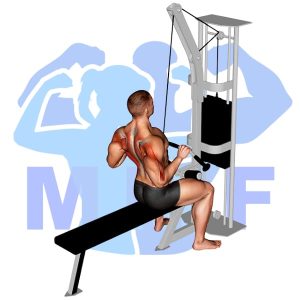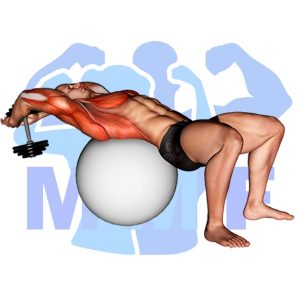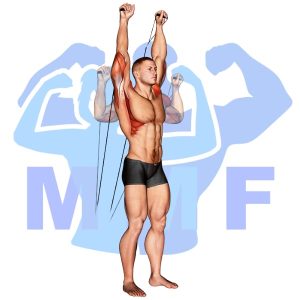Are you someone who struggles with targeting their back muscles during workouts? Have you tried various exercises, but still can’t seem to get the results you desire? One exercise that is often overlooked but incredibly effective for isolating the lats is the cable straight arm low pulldown. The reason this exercise is often neglected is that it requires proper form and isolation, which can be difficult to achieve. Don’t worry, it’s not your fault, as most people lack the knowledge or technique for this exercise. But fear not, in this post, I will guide you step by step through the correct form and techniques to master the cable straight arm low pulldown, so you can achieve a strong and toned back.
Cable Straight Arm Low Pulldown Summary
- Primary Muscles: Latissimus Dorsi
- Secondary Muscles: Deltoid – Posterior, Levator Scapulae, Pectoralis Major – Sternal, Pectoralis Minor, Rhomboids, Teres Major, and Triceps Long Head
- Equipment: Cable Machine with Straight Bar
- Mechanics Type: Compound
- Force: Pull
- Utility: Basic

Cable Straight Arm Low Pulldown Instructions
- First, set up a straight or pulldown bar from a high pulley.
- Now stand up straight and grab the bar with both with an overhand grip with both hands shoulder-width apart.
- Pull the bar down in front of you, keeping your arms straight until the bar is at your upper thigh.
- Then allow the cable to pull the bar back up to about waist high.
- Then repeat the pulldown with your arms locked, pulling the bar back down to your thighs.
- Continue the low pulldowns for a set of 8-15
Video Tutorial
Cable Straight Arm Low Pulldown Muscles
Target (Agonist)
- Latissimus Dorsi
Synergists
- Deltoid – Posterior
- Levator Scapulae
- Pectoralis Major – Sternal
- Pectoralis Minor
- Rhomboids
- Teres Major
- Triceps Long Head
Dynamic Stabilizers
- None
Stabilizers
- Deltoid – Lateral
- Deltoid – Posterior
- Erector Spinae
- Gluteus Maximus
- Pectoralis Major – Clavicular
- Pectoralis Major – Sternal
- Pectoralis Minor
- Rhomboids
- Trapezius – Lower
- Trapezius – Middle
- Triceps
Antagonist Stabilizers
- None

Benefits of Cable Straight Arm Low Pulldown
The Cable Straight Arm Low Pulldown is an effective exercise for strengthening the Latissimus Dorsi muscle. This exercise targets the middle and lower lats, providing an intense workout that helps build strength and stability in the upper body. Additionally, performing this exercise correctly can also help build core stability and improve posture. The Cable Straight Arm Low Pulldown is an important part of any strength training or fitness routine, as it strengthens the Latissimus Dorsi muscle to help athletes achieve their goals.
Tips for Performing Cable Straight Arm Low Pulldown
Your at the right place if you’re motivated to advance your cable straight arm low pulldown execution. These tips can get you more from of this effective workout, and help you receive all the benefits it has to give. Concurrently with building your lats muscles, improving movability, and also a reduced possibility of injury can all be accomplished with this exercise. Let’s begin and take a look at how these tips will benefit you.
- Maintain Proper Posture: Ensure your back is straight and your shoulders are pulled back while you perform the exercise. This will help to target the correct muscles while avoiding any potential strain on the lower back.
- Use a Slow Tempo: Performing the exercise with a slow, controlled tempo will help you to maximize the benefits of the exercise and avoid potential injury.
- Engage Your Core: Engaging your core muscles while performing the exercise will help to increase the intensity and ensure that you are using the correct muscles during the exercise. This will result in better overall results and improved fitness.
Benefits and Tips Video
Frequent Mistakes To Avoid
Staying away from errors can be the distinction between a productive training session and an injury when performing cable straight arm low pulldown. Additionally, getting the most out of the exercise requires appropriate form, and making sure you don’t perform common errors can allow you to perform the exercise correctly and obtain your desired results. But relax, it’s not quite as difficult as it might seem. By knowing the mistakes to avoid and taking the appropriate actions, you may complete the exercise securely and successfully. So it is time for you to maximize your results from this exercise and enjoy the benefits of a productive workout.
- Not using the proper form: Proper form is essential in order to get the most out of this exercise and prevent injury. The wrong form can lead to improper muscle activation, which can reduce the effectiveness of the exercise and cause injury.
- Not using proper breathing: Proper breathing is critical for maximum muscle activation, and it is important to exhale on the effort of the exercise and inhale on the return. Not breathing properly can make the exercise less effective and put strain on the body.
- Not adjusting the weight appropriately: It is important to adjust the weight of the cable accordingly to ensure that you are challenging yourself but not straining your body. If the weight is too heavy, it can lead to injury, and if it is too light, you won’t get the full benefit of the exercise.
Find More Cable Exercises Here
Variations and Complementary Exercises
There are many variations, complementary, and alternative exercises to the Cable Straight Arm Low Pulldown that can help you achieve similar results. These exercises are great for targeting the same muscles as the Cable Straight Arm Low Pulldown, but with a different angle or using different equipment. Let’s take a look at some of these exercises.
Chin Up

Chin Up is a great exercise to complement or act as an alternative to the Cable Straight Arm Low Pulldown. It works the same muscle groups but in a slightly different way. Chin Up requires more upper body strength and stability as you are lifting your entire body weight. It also activates the latissimus dorsi more, giving you more back width and thickness. Additionally, Chin Up puts less stress on the shoulders, making it a great option for those with shoulder injuries. By incorporating Chin Up into your workout routine, you can improve your overall back development and strength.
Close Grip Chin Up

The Close Grip Chin Up is a great complementary or alternative exercise for the Cable Straight Arm Low Pulldown. This exercise is similar to the pulldown, but instead of using the cable you use your body weight. By performing a chin up, you will be engaging the same muscles used in the pulldown, but with a slightly different angle. Your back, shoulders and biceps will be working together to pull your body up and over the bar. The close grip of the chin up provides additional emphasis on the biceps and shoulder muscles. This exercise is great for developing upper body strength and muscular balance between the back and arms.
Dumbbell Straight Arm Pullover

The dumbbell straight arm pullover is a great complementary or alternative exercise to the cable straight arm low pulldown. It targets the same muscle groups—mainly the lats and triceps—but with slightly different form and emphasis. When performing the dumbbell pullover, the arms are kept straight and remain extended throughout the entire movement. This helps to further isolate the lats and triceps, making this a great isolation exercise for these muscles. In addition, the dumbbell pullover also works the chest muscles, allowing for a more balanced workout.
Check Out These Top Cable Exercises
Neutral Grip Lat Pulldown

The Neutral Grip Lat Pulldown is a great alternative or complementary exercise to the Cable Straight Arm Low Pulldown. The Neutral Grip Lat Pulldown is a great way to target the latissimus dorsi, which is the largest muscle in the back. This exercise is performed by sitting upright and gripping the bar with a neutral grip, then pulling the bar down towards the chest. The Neutral Grip Lat Pulldown is similar to the Cable Straight Arm Low Pulldown, but it engages the lats more effectively and can be done with heavier weights than its counterpart. Both exercises are great for toning and strengthening the back muscles and should be incorporated into any back workout routine.
Stability Ball Dumbbell Pullover

The stability ball dumbbell pullover is a great complementary exercise to the cable straight arm low pulldown. This move uses a stability ball to target your back muscles and core, while also engaging your shoulders and arms. It’s a great alternative exercise that allows you to challenge your body in different ways and build strength, stability and balance. This exercise is perfect for those who want to work their back muscles without having to use a cable machine or heavy weights. It’s also a great way to switch up your routine and add variety to your workouts.
Wide Grip Pull Up

Wide Grip Pull Ups are an excellent alternative or complementary exercise to the Cable Straight Arm Low Pulldown. This compound exercise targets multiple muscles in the back, as well as the biceps and shoulders. The wide grip pull up requires you to pull your body up with a wide grip, using your lats and other muscles in your back. This exercise helps build strength in the upper body, while also improving stability and core strength. It is an ideal exercise for those looking to increase their upper body strength, and it can be used as a substitution for the Cable Straight Arm Low Pulldown.
Find More Back Exercises Here
Opposing Complementary Exercises
To maximize the effectiveness of the Cable Straight Arm Low Pulldown, try pairing it with exercises that target the opposing muscles. These exercises will help to create balance in your upper body and ensure that you are getting a well-rounded workout. The following exercises will help to strengthen the opposing muscle groups:
Barbell Standing Wide Military Press

The Barbell Standing Wide Military Press is an excellent upper body exercise that works the deltoids, trapezius, and triceps. This exercise is complementary to the Cable Straight Arm Low Pulldown, which works the lats, rhomboids, and biceps. Both exercises target opposing muscle groups, making them perfect for pairing together in a workout routine. The Barbell Standing Wide Military Press helps to strengthen and tone the upper body by engaging the pressing muscles, while the Cable Straight Arm Low Pulldown helps to strengthen and tone the back by engaging the pulling muscles. Both exercises can be done in a circuit to increase strength and muscular endurance.
Cable Shoulder Press

The Cable Shoulder Press is an excellent complementary exercise to the Cable Straight Arm Low Pulldown as it works the opposite muscle group. The Shoulder Press focuses on the anterior deltoid, as well as the trapezius and triceps muscles. This exercise is performed by standing with feet hip-width apart and holding a cable bar in both hands. The bar should be at chest level and the arms bent at the elbow. From this position, the arms should be extended outwards while keeping the elbows slightly bent. This exercise helps to strengthen the shoulder muscles and build muscular endurance. By performing both exercises in succession, you will be able to achieve a balanced workout and improve your overall upper body strength.
Dumbbell Arnold Press

The Dumbbell Arnold Press is a great complement to the Cable Straight Arm Low Pulldown exercise. It works the shoulder muscles in the opposite direction of the Cable Straight Arm Low Pulldown, providing balance and stability to the shoulder joint. The Dumbbell Arnold Press targets the anterior deltoids, medial deltoids, and triceps muscles, while the Cable Straight Arm Low Pulldown targets the posterior deltoids, lats, and rhomboids. This combination of exercises helps to build strength and endurance in both the front and back of the shoulder while also stabilizing the shoulder joint.
Get Fit with Cable Straight Arm Low Pulldown!
If you’re looking to sculpt and tone your back muscles, the cable straight arm low pulldown is a great exercise to add to your routine. This move targets your lats, trapezius, and rhomboids while also engaging your core. One of the benefits of this exercise is its versatility. You can vary the weight and resistance to suit your fitness level, and there are different attachments you can use depending on the equipment available at your gym. Additionally, by maintaining a slow and controlled movement, you can maximize the results of this exercise.
References: Wikipedia | ExRx.net | PubMed.gov | Comprehensive List of Back Cable Exercises




